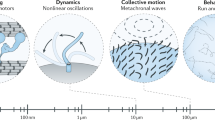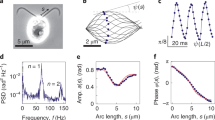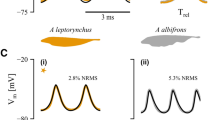Abstract
THE membranelles (compound cilia) of the protozoan Stentor are arranged in a single row around the oral end of the animal. Each membranelle swings through an angle of beat of about 140° in a plane at right angles to the row, while the metachronal waves pass along the row from one end to the other. It has been established1,2 that these membranelles are normally co-ordinated to beat in a metachronal rhythm by an internal transmission mechanism, so that the conduction of metachronal ‘impulses’ and the beating of the cilia are separable activities of the system, having quite different properties.
This is a preview of subscription content, access via your institution
Access options
Subscribe to this journal
Receive 51 print issues and online access
$199.00 per year
only $3.90 per issue
Buy this article
- Purchase on Springer Link
- Instant access to full article PDF
Prices may be subject to local taxes which are calculated during checkout
Similar content being viewed by others
References
Sleigh, M. A., J. Exp. Biol., 33, 15 (1956).
Sleigh, M. A., J. Exp. Biol., 34, 106 (1957).
Gosselin, R. E., Fed. Proc., 17, 1468 (1958).
Aiello, E. L., Physiol. Zool., 33, 120 (1960).
Sleigh, M. A., Ph.D. thesis, University of Bristol (1956).
Gray, J., Proc. Roy. Soc., B, 107, 313 (1930).
Author information
Authors and Affiliations
Rights and permissions
About this article
Cite this article
SLEIGH, M. An Example of Mechanical Co-ordination of Cilia. Nature 191, 931–932 (1961). https://doi.org/10.1038/191931a0
Issue Date:
DOI: https://doi.org/10.1038/191931a0
This article is cited by
-
Progress in the study of excitation and response in ciliates
Protoplasma (1966)
Comments
By submitting a comment you agree to abide by our Terms and Community Guidelines. If you find something abusive or that does not comply with our terms or guidelines please flag it as inappropriate.



